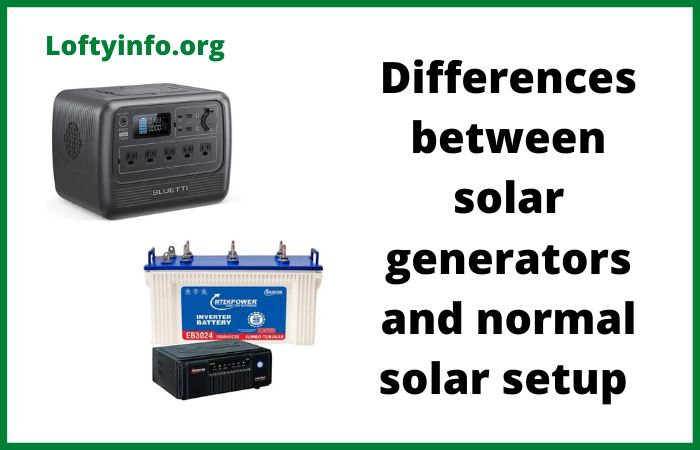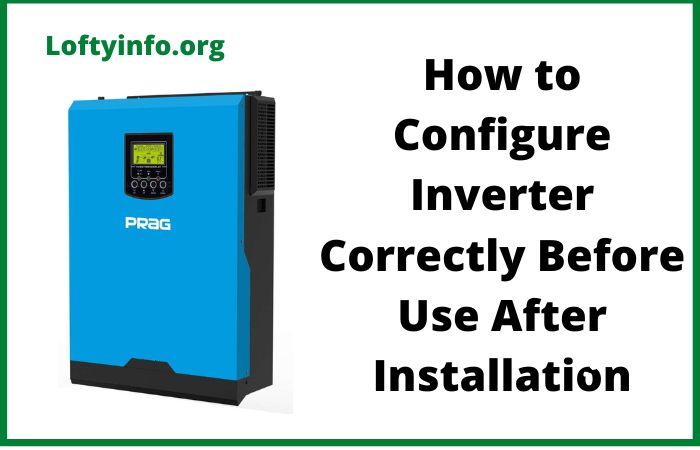Differences Between Solar Generators And Traditional Solar Systems
The solar energy market offers two distinct paths for homeowners and outdoor enthusiasts looking to harness the power of the sun.
While both solar generators and traditional solar panel installations convert sunlight into usable electricity the similarities largely end there.
Making the wrong choice can lead to wasted money on a system that doesn’t meet your actual power needs or overspending on capacity you’ll never use.
Understanding the fundamental differences between these two solar solutions helps you make an informed decision that aligns with your energy requirements budget and lifestyle.
Differences Between Solar Generators And Traditional Solar Systems
1) Installation Complexity and Permanence
Traditional solar panel systems require professional installation that typically takes two to three days and involves permanently mounting equipment to your property.
Certified installers assess your roof structure drill mounting points and secure aluminum racking systems that hold solar panels in place.
They run electrical conduit through your attic or along exterior walls to connect panels to an inverter and then integrate the entire system with your home’s electrical panel and the utility grid.
This process requires permits from local building departments inspections by electrical authorities and coordination with your utility company for grid interconnection approval.
The installation creates permanent modifications to your property including roof penetrations that must be properly sealed and flashed to prevent water damage.
Solar generators represent the complete opposite approach to solar power.
These portable units arrive fully assembled in a single package that requires no installation expertise.
You simply remove the generator from its box place it in your desired location and connect the included solar panels using plug-and-play connectors.
The entire setup process takes 15 to 30 minutes and involves no tools permits or professional assistance.
The solar panels that come with generators use folding designs or portable stands that sit on the ground or any flat surface without permanent mounting.
You can move the entire system from your backyard to your garage to your vehicle and take it on camping trips or use it at different properties.
This portability makes solar generators ideal for renters who cannot modify their living spaces and for anyone who values flexibility over permanent infrastructure.
The trade-off is that portable panels must be manually positioned to track the sun throughout the day and are more vulnerable to weather damage theft or accidental damage compared to securely mounted rooftop arrays.
2) Power Capacity and Scalability
Traditional residential solar installations typically range from 5 kilowatts to 12 kilowatts for average homes with larger properties, sometimes installing systems up to 20 kilowatts or more.
A 6 kilowatt system consists of approximately 15 to 20 solar panels depending on individual panel wattage and can generate 24 to 30 kilowatt-hours of electricity per day under optimal conditions.
This amount of power can run your refrigerator air conditioning, lighting water heater and all other household appliances simultaneously throughout the day.
The system connects directly to your home’s electrical panel and feeds power to every circuit in your house just like utility electricity.
You can expand traditional systems by adding more panels and upgrading inverter capacity to accommodate increased energy needs from electric vehicle charging, new appliances or home additions.
Most residential roofs have space for system expansion allowing you to scale up by 30 to 50 percent if needed.
Solar generators operate on a much smaller scale with power capacities ranging from 300 watts for basic units to 3000 watts for premium models.
A mid-range 1500 watt solar generator paired with 400 watts of solar panels generates approximately 1.6 to 2.4 kilowatt-hours per day depending on sunlight conditions.
This power level can run a refrigerator for several hours, charge multiple electronic devices and power LED lighting but cannot support high-draw appliances like air conditioners, electric stoves or clothes dryers.
Solar generators store energy in built-in battery packs rather than feeding your home’s electrical panel directly. You plug appliances and devices into the generator’s AC outlets,
USB ports and 12-volt car outlets just like using a portable power station.
Some premium solar generators allow you to chain multiple units together to increase total capacity but this approach becomes expensive and cumbersome compared to traditional systems.
The fundamental limitation is that solar generator panels rarely exceed 600 watts of collection capacity which severely restricts daily energy production compared to traditional rooftop arrays measuring thousands of watts.
3) Energy Storage and Grid Interaction
Traditional solar systems operate in one of three configurations that determine how they interact with energy storage and the electrical grid.
Grid-tied systems without batteries are the most common and affordable option.
These systems feed excess solar production directly to the utility grid during sunny periods and draw power from the grid when solar production is insufficient or at night.
Your utility meter runs backward when exporting power creating net metering credits that offset your electricity costs.
Grid-tied systems with battery backup add a battery bank typically ranging from 10 to 20 kilowatt-hours that stores excess solar energy for use during evening hours or power outages.
The batteries charge during the day from solar production and discharge at night or when grid power fails providing seamless backup power to critical loads.
Off-grid systems combine large solar arrays with substantial battery banks of 30 to 60 kilowatt-hours or more plus backup generators to provide complete energy independence without any utility connection.
These systems require careful sizing to ensure adequate power generation and storage for multi-day periods of cloudy weather.
Solar generators function exclusively as off-grid battery systems with no capability to connect to the utility grid or participate in net metering programs.
The built-in battery pack stores all energy collected by the solar panels until you use it to power devices and appliances.
Battery capacities in solar generators range from 300 watt-hours in small units to 3000 watt-hours in large models with some expandable systems reaching 6000 watt-hours when using additional battery modules.
To put this in perspective a 2000 watt-hour solar generator stores enough energy to run a full-size refrigerator for about 20 hours or charge a laptop 20 times.
Once the battery depletes you must wait for solar panels to recharge it or plug the generator into grid power for faster charging.
You cannot export excess energy back to the grid to earn credits or offset costs.
The self-contained nature of solar generators makes them excellent for emergency backup power during short outages or for powering devices in locations without electrical infrastructure but they cannot replace grid power for whole-home energy needs or reduce your monthly electricity bills through net metering.
4) Cost Structure and Financial Returns
Traditional solar installations represent significant upfront investments with costs ranging from $15,000 to $30,000 for typical residential systems before incentives.
The federal solar tax credit reduces this cost by 30 percent and many states offer additional rebates or tax incentives that further decrease out-of-pocket expenses.
Financing options include solar loans that require no down payment and solar leases or power purchase agreements that eliminate upfront costs entirely.
The long-term financial proposition centers on electricity bill savings with most homeowners saving $1,000 to $2,000 annually on energy costs.
Systems typically achieve payback in 6 to 10 years and continue generating free electricity for 25 to 30 years beyond the payback period.
Traditional systems also increase home property values with studies showing that solar installations add approximately $15,000 to resale values on average.
The system qualifies for accelerated depreciation benefits for commercial properties and produces renewable energy certificates in some markets that provide additional revenue streams.
Solar generators cost between $500 and $3,500 depending on capacity and features with additional solar panels adding $300 to $1,000 to the total investment.
These lower upfront costs make solar generators accessible to people who cannot afford traditional installations or who rent their homes.
The financial return model differs fundamentally from traditional systems because solar generators do not reduce your utility bills or provide ongoing cost savings.
You continue paying the same electricity rates to your utility company while using the solar generator as a supplemental power source for specific applications.
The value proposition centers on emergency preparedness and convenience rather than long-term financial returns. Solar generators do not qualify for federal tax credits or most state incentives because they are considered portable appliances rather than permanent home improvements.
You cannot depreciate them for tax purposes or monetize their energy production through net metering or renewable energy certificates.
The purchase represents a one-time expense for backup power capability and off-grid energy access rather than an investment that generates returns over time.
5) Maintenance Requirements and Lifespan
Traditional solar panel systems require minimal maintenance over their operational lifespan but the maintenance that is necessary involves working at height on your roof.
Panel cleaning two to four times per year removes dust pollen bird droppings and other debris that reduces energy production.
Many homeowners hire professional solar cleaning services that charge $150 to $300 per cleaning to safely access rooftop arrays.
You should visually inspect roof-mounted hardware annually for loose bolts corroded connections or damaged components and schedule repairs promptly to prevent minor issues from becoming expensive problems.
Inverter replacement becomes necessary after 10 to 15 years at costs ranging from $2,000 to $3,000 depending on system size.
Panel performance degrades slowly over time typically losing 0.5 percent efficiency per year but the panels continue producing power for 25 to 30 years or longer.
Electrical connections require periodic inspection and tightening to maintain optimal performance and prevent power losses from resistance.
Tree trimming becomes an ongoing expense if vegetation grows to shade your panels over time.
Solar generators demand much less maintenance due to their ground-level accessibility and simpler construction. The portable solar panels require cleaning with soap and water every few months or after exposure to dusty conditions.
You simply spray the panels with a garden hose and wipe them with a soft cloth taking just minutes to complete.
Battery maintenance involves monitoring charge cycles and avoiding complete discharge or prolonged storage at full charge states that accelerate battery degradation.
Lithium batteries in modern solar generators last for 2,000 to 3,500 charge cycles before capacity drops to 80 percent of original specifications.
This translates to 5 to 10 years of practical use depending on how frequently you cycle the battery.
Unlike traditional systems where you replace just the inverter while keeping panels the entire solar generator becomes obsolete when the battery degrades.
Replacement costs equal buying a new unit because batteries represent 40 to 50 percent of the generator’s total value and are not economically repairable.
The portable nature of solar generators exposes them to more physical wear and tear from transport and storage requiring careful handling to prevent damage to solar panels, control electronics and battery connections.






